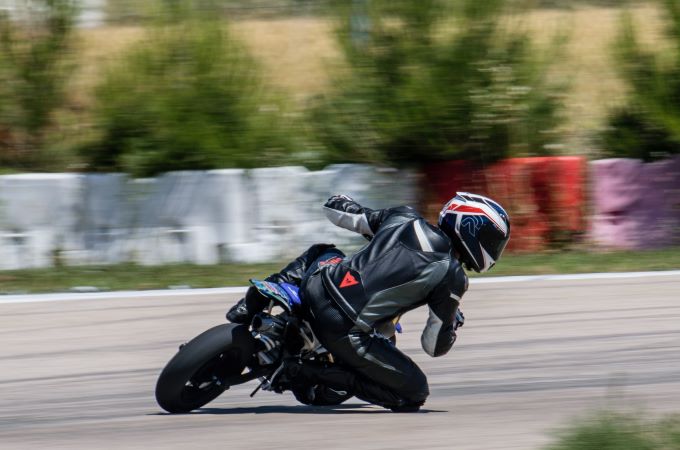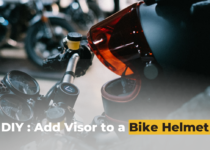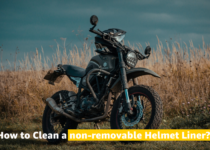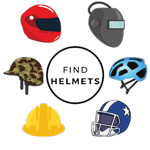Motorcycle Helmet Safety Ratings: Complete Guide
Welcome to an in-depth guide to motorcycle helmet safety ratings. Here, let’s dive into the deep world of helmet safety and head protection class. Here we will learn about the testing methods and standards that rate motorcycle helmets.
Let’s start with a little history
Before we get into today’s helmet safety testing, it’s a good idea to first learn about the history of the safety of rider\s head. We often take for granted the virtual brave of helmets. These include helmet styles, materials, colors, shapes, and sizes that are available to a modern motorcyclist. But, in the beginning, options were a little more limited. Although those helmets made of leather looked like upside-down cowhide diapers. How can that be safe? But they were. These helmets were so effective that several board track riders survived many races!
Real progress in helmet technology occurred back in 1935. It was the time when bikes were the cause of deaths in some novelists and army officers. Around that time, a neurosurgeon named Sir Hugh Cairns got motivated to research the consequences to the brain after a motorbike crash. FYI, the first “crash helmets” was the result of his experiments.
Then, Mr. Cairns crash helmet was a good starting point; however, the helmet only gave limited protection. At that time, a Californian named Herman Roth designed a modern helmet with a layer of energy-absorbing lining. This futuristic helmet has it all: an inner layer of safety, a floating inner suspension system, a hard outer shell with a visor. Moreover, the chinstrap was like the cherry on top. Later, in the 1950s, this became the industry standard for motorcycle helmet design.
Then in 1936 Pete Snell, a racing car driver, died after a collision while wearing a helmet based on the Roth design. A year later, Pete’s friends established the SNELL Memorial Foundation to honor Pete. Here, a collection of scientists and engineers came up with ways to measure the efficiency of helmets. These later became safety standards for Helmet safety testing.

What’s the deal with all the stickers?
Often at the rear of your helmet, you’ll see a variety of stickers. These stickers mean several certifications; some of them are as follows:
DOT
Standards set by the United States Department of Transportation. The current DOT rating is FMVSS 218 federal standard and any helmet with the DOT label should fulfill special criteria.
ECE
The Economic Commission for Europe’s standards. Over 30 European nations use
this transnational standard.
SNELL
The Snell Memorial Foundation establishes the Snell standards. Only a few race organizations need this optional testing technique. For street usage, the current standard is SNELL M2020.
FIM
It is one of the most recent ratings available for motorcycle helmet safety ratings. Since helmets easily fulfill the safety requirements of a motorcycle. This association is the motorcycling’s worldwide racing association for track usage. Helmet look-alikes or replicas often lack a DOT or ECE label making them “novelty” helmets. They’re dangerous as they provide no real protection.
They’re even prohibited to wear while riding in regions or conditions where helmet wearing is punishable by law. Since helmets can meet one, two, or all three standards, thus you might have a helmet that meets only DOT, DOT, and SNELL, or DOT and ECE.
A fourth testing body has just joined the motorcycle helmet industry. The SHARP helmet safety plan does not provide certificates, instead, it assigns a “star grade” to European-style lids.
Making a Difference
When we talk about security, we’re talking about energy. Your motorcycle’s energy is what makes it so enjoyable to ride! In addition, if that energy gets to your head, as in a car accident, the implications can be disastrous. Inside the helmet is a solid, head-shaped structure known as a “headform.” These headform with microscopic sensors that can sense acceleration. Automobile accidents are very predictable; Hence, testing against real-world scenarios is simple. Motorcycle crashes may sound difficult when you include variables into the mix. These are:
- Rider and machine positions
- Surroundings
- Contact surfaces
- Other vehicles, objects, and so on.
As mentioned there’s no realistic method for motorcycle collisions testing. Instead, motorcycle helmet impact testing evaluates your lid’s capacity of impact energy. This knowledge later gets converted into your helmet’s “safety.”
A concentrated “hemi” or “edge” anvil may significantly enhance the amount of energy in a hit.
When talking about helmet safety, the first thing that springs to mind is impact protection. But, there are several other crucial aspects that influence how “safe” a helmet is. Penetration protection, vision, chinstrap retention, and emergency removal affect helmet’s performance. In addition to impact testing, a helmet may face some other tests, depending on the testing body.
The Helmet safety routine
Each helmet safety standard has its own set of tests, methods, and requirements. Let’s take a deeper look at each helmet safety system:
FMVSS 218 (Department of Transportation)
The DOT helmet safety standard is the most “basic” of helmet standards. Yet the testing technique is actually rather comprehensive than others. The Department of Transportation sets stringent criteria for a helmet. It also features one of the more stringent impact test procedures. Each requirement’s testing approach is thoroughly defined and allows minimal space for mistakes.
Unfortunately, FMVSS 218 is one of the few standards that’s never tested by an issuing authority. Instead, independent contractors test helmets at random in the hopes of catching the defective lids. The idea is, like random drug testing, where the threat of getting caught will be enough to keep everyone honest.
ECE22.05
Compared to DOT standard, the ECE 22.05 standard is much younger. It provides a more extensive battery of tests than its American counterpart does. ECE standards check safety elements that can help prevent an accident from occurring. Such as the visual quality of face shields, as well as other safety aspects like shell stiffness. In contrast to the DOT, every ECE 22.05 approved helmet type gets evaluated against the standard by an independent lab. This is before the helmet gets an ECE sticker.
The average motorcycle’s collision speed in Europe is much lower than in the United States. It’s because of the considerable impact on the design of ECE impact testing. In ECE testing, a smooth anvil called a curbstone is utilized, which provides a far lower energy strike than a hemi anvil (used in SNELL and DOT testing). ECE impact tests only use a single hit, resulting in an overall low-energy testing technique.
DOT and SNELL testing enables a technician to hit a helmet at any place within a given range. ECE tests however require the strikes made at specific locations. This opens the door to helmet manufacturers “gaming the system”. This means beefing up protection at specific spots in order to pass a dangerous helmet.
M2020 SNELL
For many years, the SNELL Memorial Foundation was the darling of the helmet industry. It’s still widely regarded as the gold standard for helmet safety. For motorcycle helmet safety ratings, SNELL M2020 uses the most aggressive anvil profile, known as an edge anvil. It’s used for SNELL M2020 certification, which requires a low 275 g maximum energy transfer after two impacts.
SNELL testing is developed with the racetrack’s energy levels and safety needs in mind. This is reflected in extra testing for attributes like stability and ease of removal in an emergency. SNELL technicians check for the helmet’s weakest point, such as a metal visor snap or mechanical hinge — and then test at that point. Technicians will test at various sites until they’re satisfied with the helmet’s energy-management capabilities. SNELL also performs “helmet autopsy”. It involves inspecting the internal components for indicators of weakness.
The M2010 SNELL standard received considerable criticism for encouraging “overly hard” EPS liners. The liners were so stiff that they actually enabled increased force transmission for lower energy impacts. This made some sense in theory, however, the reasoning did not stand up in practice. The anvil forms used in SNELL testing include flat, hemi, and edge. While the edge anvil is the most severe form, the flat anvil is the same as the one used by the ECE and DOT. If a helmet was true “too hard” to be safe in low-speed collisions, it would allow more energy transfer during a flat anvil hit, failing the test.
SHARP
The SHARP Helmet Safety Scheme, a relative newcomer to the safety game. It is the first organization to go beyond “pass/fail” motorcycle helmet certification. SHARP evaluates each helmet using a variety of impact locations and energy levels before assigning it a “star rating.” This rating reflects a helmet’s ability to manage energy. You know that DOT, ECE, and SNELL ratings are standalone safety certifications for motorcycle helmet safety ratings. The SHARP rating is an impact rating upgrade to the ECE 22.05 standard.
As a result, SHARP will only test helmets that have previously received ECE certification.
The SHARP safety scheme’s aim is not to establish if a helmet is completely “safe”. But to give European customers additional information when picking between ECE-certified lids. SHARP employs a testing procedure that is very like the ECE 22.05 system. But adds a higher and lower velocity hit to the mix. SHARP then calculates a color-coded “safety rating” for each part of the helmet based on European crash data.
SHARP has polarized a large part of the helmet-buying community. The safety scheme’s supporters appreciate SHARP’s more rigorous testing techniques. These include the color-coded “zone” breakdown of each tested lid, and the “star rating” system as a valuable tool for comparing helmets.
Critics of SHARP say that the “star ratings” oversimplify things like helmet safety and color-coded rating. It’s based on a single hit point within a zone and does not account for the variety of variables in a motorbike incident, and hence is deceptive. Whatever your feelings are about the SHARP safety plan, keep in mind that it was expressly created for the European market. For the ones who seek a DOT helmet, keep in mind that the lid examined by SHARP may be different from the one you buy. But make sure it has a good motorcycle helmet safety ratings.
To recapitulate, below is a summary of the benefits and drawbacks of each certification.

FMVSS 218 (Department of Transportation)
Advantages
- High-energy testing system that employs a hemispherical anvil and two blows per site.
- The technician may strike the helmet anywhere throughout a vast coverage area.
- The maximum permitted energy transfer of 400 g peak is reasonable.
CONS
- The “honor system” of random testing is inadequate, and many DOT-labeled helmets may not meet the criteria.
- There are just a few headforms utilized.
- Some testing isn’t connected to the influence of energy management. There will be no testing of optics, removability, friction resistance, or a variety of other crucial variables.
ECE22.05
PROS
- Standards are actively and fully checked on all ECE-certified helmets. Very low peak energy permitted (only 275 g) .
- Extensive testing for a wide range of safety-related aspects.
- There are eight headforms providing a wider variety of testing factors.
CONS
- The use of a curbstone anvil and a single hit results in extremely low-energy testing. It may be too low for the greater speeds seen in the United States.
- Fixed helmet striking placements allow for impact testing clean.
- Headform variation can result in a shifted center of gravity during testing, which can reduce impact energy by up to 20%.
SNELL M2020
PROS
- Standards are actively and extensively checked on all SNELL-certified helmets.
- Allowable peak energy is quite low (only 275 g)
- Stability, removability, and face shield shattering testing
- Anvil testing with extreme “edges” powerful impact energy
- Technicians constantly seek weak places on the helmet to ensure the most complete testing possible.
CONS
- The increased expense of private SNELL testing reflects in its higher retail price of certified helmets.
- Because of the race-oriented character of SNELL, helmets with valuable street options may get excluded
SHARP
BENEFITS
- Testing highs and low-velocity impact on Helmets, which no other testing system does.
- A comprehensive battery of impact testing
- Each helmet has five impact points.
- Performing A “helmet autopsy” after the incident to identify possible weak areas.
- Rating systems provide consumers with more than a basic “pass/fail” decision.
CONS
- There is debate over the usefulness of “star” and “color code” rating systems.
- The testing is based on European crash data as the energy levels and riding circumstances in the United States.
- Curbstone and flat anvils represent lower energy levels than DOT and SNELL-controlled hemi anvils.
So, which is the better rating?
In the motorcycle industry, there is an old adage that goes, “Tell me how you’re going to crash, and I’ll tell you what protection you need.” The same is true for helmet certifications. If you want to get into a low-speed fender bender someplace in London, an ECE-rated helmet would most likely suffice. If you’re going to take a spill on L.A.’s 405 highway, a SNELL-certified lid could be a better option. As long as they fulfill the DOT standard, DOT authorized helmets will suffice for the usual American get-off.
There are several aspects to consider when picking a helmet, and selecting the necessary safety certification is just one of them. The fit, quality, comfort, simplicity of use, and feature set of a helmet may all contribute to the rider’s overall safety. A lighter or quieter helmet might assist minimize rider fatigue, while fog-free optics can increase vision. These factors may lessen the possibility of an accident occurring in the first place.
Fit is extremely critical! In fact, all four testing agencies emphasize the need of testing on correctly fitting headforms. The capacity of your helmet will affect the control of impact energy if it does not fit properly. A $100 DOT helmet that’s properly fitted will protect you better than a $900 SNELL helmet that is overly big.
Conclusion
This was the in-depth view of motorcycle helmet safety ratings and different authorities that govern the safety regulations in helmets. As mentioned each helmet comes with a set of stickers that represent the certifications it receives. Only the right set of helmets receive those certifications only after a series of tests to ensure a safe journey while wearing a helmet. Since helmets can meet one, two, or all three standards, thus you might have a helmet that meets only DOT, DOT, and SNELL, or DOT and ECE.
As mentioned there’s no realistic method for motorcycle collisions testing. Instead, motorcycle helmet impact testing evaluates your lid’s capacity of impact energy. In addition to impact testing, a helmet may face some other tests, depending on the testing body. FMVSS 218 the DOT helmet safety standard is the most “basic” of helmet standards. You know that DOT, ECE, and SNELL ratings are standalone safety certifications for motorcycle helmet safety ratings.
Also Read: Top Drag Racing Helmets in 2022
Related Posts

How To Listen To Music In Motorcycle Helmet?

DIY: Add Visor to a Bike Helmet

